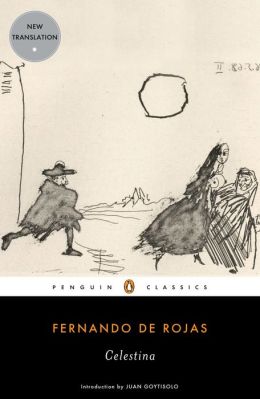[The above is mostly a
reading of the text below, with an occasional aside thrown in for good measure,
as they strike me as relevant. I welcome
questions, comments, or concerns about the material contained in this video.]
“Celestina” is one of those literary peculiarities that you might not have had the pleasure to be introduced to if you had not taken a course in Spanish literature. I first ran across the title in the Dedalus European Classics series, which has a lot of similarly obscure and wonderful things, including Georges Rodenbach and Gustav Meyrink. I was pleasantly surprised when I found out that a more mainstream publisher like Penguin had the same translation, by Peter Bush.
Celestina, the local procuress and alchemic mage, makes a living off of restoring the hymens of previously deflowered young girls so that they may be marriageable again. The rich noble Calisto has fallen in love with Melibea, yet it is wholly unrequited. He enlists Celestina to fix this, and through some crafty manipulation she eventually succeeds. Two of Calisto’s servants, Parmeno and Sempronio, promise to offer their own services to Celestina if she will split Calisto’s payment three ways. Parmeno starts out being honest, telling Calisto that Celestina is nothing but a money-hungry crook, but eventually gives up when he sees how hopelessly in love Calisto really is. Once Celestina refuses to pay them, everything starts to go horribly, horribly downhill. What read for the first two-thirds as a bawdy comedy turns into a bloodbath on par with “Hamlet.” The label tragicomedy seems especially appropriate here, having equal measures of both.
The plot is fast-paced and easy to follow. It is divided into twenty-one short, heavily dialogue-driven chapters that read very much like a play (even though it was apparently never mean to be staged). Throughout, the best advice is given through numbing, stultifying bromides, and this is especially true of Celestina. You can almost open the book randomly and find clichés, though the humor of the characters still manages to jump off the page.
Simone de Beauvoir wrote a beautiful description of Celestina in “The Coming of Age.” She wrote, “This was the first time that an old woman had appeared as the main heroine; in the traditional way she was of course a bawd, but a bawd of dimensions quite unlike those of any character who had yet been produced. She was a former whore who had stayed in the trade because she liked it, a self-seeking, lewd, and intriguing old woman, and something of a witch as well – the leading, most active character in the play [though play, as I noted above, is not the right word for this piece]. In her are summed up all the vices that had been attributed to the old women since classical times, and in spite of all her shrewdness she ends by being severely punished. The French theatre turned to this source of inspiration, but with less striking results: we find old bawds and prostitutes in Jodelle, Odet de Turnebe, and Larivey.”
The reader gets the feeling that, when it was first published at the very end of the fifteenth century, “Celestina” was meant first and foremost to be a savage critique of the reigning morality of the time. While it has lost its critical punch, it is still full of characters, ideas, and bawdy that make it enjoyable, humane, and lovable. Since it was written before most modern-day genres had the chance to fully gel, the style takes getting used to; it cannot be easily pegged down, like we do more easily with Cervantes and Shakespeare, who in theme and style and both heavily foreshadowed here (especially the former).
I can’t read Spanish, so I can’t comment on the original. However, I can recommend Peter Bush’s translation to anyone who is looking for a unique reading experience far off the beaten path.

No comments:
Post a Comment